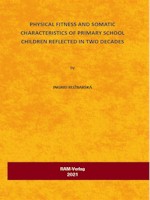|
 |
Preface
Diagnostics of human motor competence is currently still an open and dynamic system in which each piece of knowledge can contribute to the refinement and modernization of knowledge about motor development and competence of individuals in different population groups.
The concentration of the current scientific discourse on the study of the abilities and skills of the school population results from their association with the health of the individual. However, a number of formulated research problems are still open and many questions remain unanswered. There are no clearly defined (a) determinants of motor competence and (b) inter-vention possibilities; (c) secular trends in the international reference framework are marginally documented; (d) representative research data on motor differences of children in various edu-cational, sociocultural or environmental contexts are missing; and (e) the transfer of scientific knowledge into educational policies, national curricula and educational practice appears to be problematic.
The research intention of the presented scientific monograph responds in a way to the scientific research demand for the expertise of educational practice in the development of mo-tor abilities and skills of primary school children and for the establishment of modern educa-tional strategies with regard to the diversity of their psychosocial and motor development.
The presented monograph was created with the support of the grant project VEGA of MESRS SR (Ministry of Education, Science, Research and Sport of the Slovak Republic) and SAS (Slovak Academy of Sciences) (No. 1/0122/19) entitled Somatic and motor characteristics of children of younger school age and their development trends with a special focus on children from marginalized Romany communities. Regarding its research context, the project provides an excursion into the issue of trends in somatic and motor parameters of pri-mary school children within the past two decades. From the methodological viewpoint, the research is based on a comparison of the level of somatic development and motor abilities of today’s generation of younger school-age children with the research works of Turek (1999) and Horváth (2001), in which the European testing system EUROFIT was applied. This com-parative approach makes it possible to indicate generational trends in two parallel research lines. First, it provides an insight into the differences in somatic development and physical fitness of the standard school population, with research data from the late 1990s being the reference framework (Turek, 1999). The second line is represented by the research findings of Horváth (2001), which enable the identification of secular trends in somatic and motor charac-teristics of children from a s
socially disadvantaged environment coming from marginalized Roma communities. The re-search aim of this monograph also partially touches on the examination of the mentioned pa-rameters of younger school-age children from the perspective of their various socio-educational contexts (children with special educational needs or from a socially disadvantaged environment). This methodological paradigm can thus indirectly indicate the projection of socio-cultural, socio-economic and educational specifics into the level of motor development of younger school-age children. As part of the empirical intention, an analysis of the level of children’s physical fitness in terms of their weight status manifested by the body mass index (BMI) is also carried out. This partial aim allows verifying the effect of overweight on the level of participants’ motor abilities.
We believe that the research grasp of the theoretical basis in this monograph will con-tribute to updating the global scientific framework for the study of motor competence in the school population, but also to raise several questions for professional and scientific discussion.
At this point, we would like to express our gratitude to the reviewers whose professional suggestions and comments contributed to the improvement of this publication. Many thanks to all cooperating teachers at the participating primary schools for their helpfulness, willing-ness and collaboration in data collection. And last but not least, we thank the main partici-pants of the research plan – children – for their active participation, joy and enthusiasm during testing.
